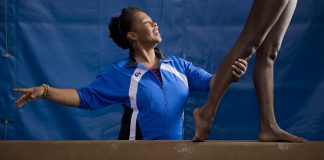Our eyes are key inputs for our coordination and movement. The body organizes itself around vision. Clear visual “data” leads to increased fluidity and performance of movement tasks, specifically those that involve a target—like making a jump-shot, hitting a putt, throwing a football accurately, or ripping the top of the net with a slap-shot.
In recent years, the technology to track vision and record eye movements has advanced exponentially. With that technology, we have new, highly detailed research on vision and its impact on performance—namely, how being able to focus on key parts of a target object or location (gaze stability) and being able to do it for longer periods of time (gaze duration) prior to initiating critical parts of a movement is a key differentiator between elite athletes and amateur athletes.
For example, one study showed that elite volleyball players serving the ball into play spent significantly less time tracking the ball with their eyes. Instead, they quickly moved their vision to the spot where their hand would be contacting the ball.
Why’s that important?
It allowed the elite players more time to visually pick up on information during the most critical part of the serve—the point in space when their hand contacts the ball—and therefore they had more time and information to coordinate that movement effectively, resulting in a better serve.
That phase of vision immediately preceding the hand hitting the ball is known as the “quiet eye” (QE). In that QE phase, your gaze has to stabilize on one point for a certain duration of time. Specifically, the quiet eye is defined, in relation to any movement task, as the final fixation gaze on an object or location within three degrees of visual angle and for at least 100 milliseconds immediately preceding the critical phase of the movement. And here’s the coolest part: QE is trainable.
It’s not simply a by-product of expertise but rather it helps contribute to expertise. This training is called…wait for it…quiet eye training. By using video feedback of gaze location and being taught pre-movement routines aimed at lengthening the quiet eye, you can increase how quickly your eye moves to the critical object/location and how long it tracks it.
Here’s a video example using soccer penalty kicks, take note of the decreased movement and better sequencing of the red circle (which signifies where the player is looking):
https://www.youtube.com/watch?v=UnXqmisYKpc
Further, in a study that used quiet eye training on skeet shooters, they had significant improvements in how quickly they located the clay, how long they tracked it, and most importantly, in their shooting performance.
Other studies have also explored and shown the benefits of quiet eye training in sports such as golf, volleyball, tennis, basketball, and soccer. Additionally, quiet eye training has shown to positively influence how fast you can learn a skill, your level of attentional focus, and been shown reduce anxiety in high stress situations.
Quiet eye training is truly the next frontier in athletic performance. It’s taking one of the key senses that is responsible for organizing our movement and fluidity, breaking it down to the moment preceding the most critical phase of movement, and then specifically training that phase. It results in improved performance, increased skill learning, and improving attentional focus during high stress/anxiety situations.
What’s not to like? Quiet eye training is the parfait of next level athletic development, and “everybody likes parfait, Shrek.”
Sources:
- Vickers, J. N. (2011). Mind over muscle: The role of gaze control, spatial cognition, and the quiet eye in motor expertise. Cognitive Processing, 12, 219-222.
- Causer, J., Holmes, P. S., & Williams, A. M. (2011). Quiet eye training in a visuomotor control task. Medicine and Science in Sports and Exercise, 43, 1042-1049.
- Causer, J., Holmes, P. S., & Williams, A. M. (2011). Quiet eye training in a visuomotor control task. Medicine and Science in Sports and Exercise, 43, 1042-1049.; Wood, G., & Wilson, M. R. (2011). Quiet-eye training for soccer penalty kicks. Cognitive Processing, 12, 257-266.Vine SJ, Moore LJ, Wilson MR (2011). Quiet eye training facilitates competitive putting performance in elite golfers. Frontiers in Psychology, doi:10.3389/fpsyg.2011.00008.;Wilson, M. R., Vine, S. J., & Wood, G. (2009). The influence of anxiety on visual attentional control in basketball free throw shooting. Journal of Sport and Exercise Psychology, 31, 152-168.
- Causer, J., Holmes, P. S., Smith, N. C., & Williams, A. M. (2011). Anxiety, movement kinematics, and visual attention in elite-level performers. Emotion, 11, 595-602.; Vine, S.J., Lee, D., Moore, L.J., & Wilson, M.R, (2013) Quiet eye and choking: Online control breaks down at the point of performance failure. Medicine and Science in Sport & Exercise, 45(10):1988-94.;Vine SJ, Wilson MR (2010). Quiet eye training: Effects on learning and performance under pressure. J Appl Sport Psychol; 22: 361-76.; Vine SJ, Wilson MR (2011). The influence of quiet eye training and pressure on attention and visuomotorcontrol. Acta Psychol; 136: 340-6.; Wilson, M. R. (2012). Anxiety: Attention, the brain, the body and performance. In S. Murphy (Ed.), Handbook on sport and performance psychology (pp. 173-190). New York, NY: Oxford University Press.; Wilson, M. R., Vine, S. J., & Wood, G. (2009). The influence of anxiety on visual attentional control in basketball free throw shooting. Journal of Sport and Exercise Psychology, 31, 152-168.Wood, G., & Wilson, M.R. (2012). Quiet-eye training, perceived control and performing under pressure. Psychology of Sport and Exercise, 13, 721–728.; Wilson, M., Miles, C., Vine, S.J., & Vickers, J.N. (2013). Quiet Eye Distinguishes Children of High and Low Motor Coordination Abilities. Medicine & Science in Sports & Exercise. 45(6):1144-51.; Vickers, J. N., & Lewinski, W. (2012). Performing under pressure: Gaze control, decision making and shooting performance of elite and rookie police officers. Human Movement Science, 31(1), 101-117.













